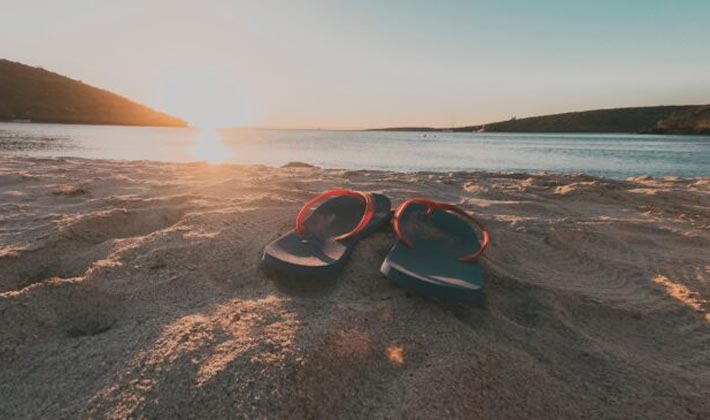On hot summer days, sandals can be an easy breezy footwear choice. But, it’s important to choose your footwear carefully based on your planned activity and not the weather. Most sandals are not appropriate for long walks or exercise. They’re also not your best bet for activities such as running errands all day, walking the dogs or standing all day at work. Running or walking shoes may be more suited for these kinds of activities to help prevent or reduce foot pain at the end of the day.
Why are sandals not appropriate? Here are five features of sandals/flip flops that aren’t good for prolonged time on your feet:
Thin Base/No Cushioning

Most sandals have a much thinner base than running shoes. This reduces the cushioning and shock absorption of the shoe. If the shoe is not absorbing the shock, this force needs to go somewhere. That somewhere may be your feet or knees. The longer you walk, the more force that accumulates on your feet and knees. With a thicker base, some of the shock is absorbed in the sole. This reduces the force at your feet and legs, allowing them to last longer without pain developing.
No Heel Support
Heel support in your shoes is measured by the heel counter, which is the area directly behind the heel. To test the support at the heel counter, push on the back of the heel. The heel counter should be stiff.
Sandals lack support in this area because most will have a flimsy strap, or nothing at all. The heel counter holds the heel in place and prevents it from moving around. Those who are flat footed may have an issue with excessive heel movement, where this heel support becomes especially important.
Excessive motion at the heel may lead to pain and discomfort in your lower limb, especially after a long walk.
No Arch Support
This arch support can be from a custom orthotic or supportive insole, or from the stiffness of the midsole (thick sole area). The midsole stiffness holds the foot in place and prevents excessive motion around the arch.
Most sandals have a flexible midsole and a flat arch, lacking in support. Some sandals have a built-in arch support, which improves the support in the sandal. Even with this extra support, sandals are still not recommended for long walks due to the other factors explained in this article.
Straps
Sandals contain straps instead of a full upper (material on the top of the shoe). The limited material on the top of the foot allows the foot to move around more. This could become an issue when on long walks because it would be more likely to roll an ankle. Also, the toes may grip more often to keep the sandal on the foot, which may lead to issues at the ball of the foot. In terms of support, straps don’t do a good job with holding your foot in place, which can be an issue for lower limb pain. This is especially true for those with flat feet because the feet tend to move around more often and need additional support to prevent this motion.
No Toe Protection
The problem with an opened toed sandal during long walks it that it exposes your toes to potential obstructions. As you start to tire on longer walks, you may inadvertently become careless and injure your exposed toes.
Before you walk out the door, think about the type of activity you are doing and adjust your footwear accordingly! If your sandals don’t have any of these problematic features then you’ve chosen well and they may be suitable for longer walks or activities. If you would like specific advice, talk to your local pedorthist for more personalized information!
By Julia Hayman C. Ped (C)
